|

Reference Guide
|
|
How To / Using the Printer Driver with Windows
Making Changes to Printer Settings
 Choosing the print quality
Choosing the print quality
 Resizing printouts
Resizing printouts
 Modifying the print layout
Modifying the print layout
 Using watermarks
Using watermarks
 Using an overlay
Using an overlay
 Resetting the toner and the photoconductor counters
Resetting the toner and the photoconductor counters
Choosing the print quality
You can change the print quality or resolution of printouts to favor speed or detail. If you need high quality output, choose a higher number. Please note that doing so reduces the print speed.
There are three levels of print output, 600 dpi, Class 1200 dpi, and 1200 dpi. Class 1200 dpi provides high quality printing results on par with 1200 dpi with the Enh. MG and RITech functions (under 600 dpi).
 |
Click the Basic Settings tab.
|
 |
Select the desired printing resolution from the Print Quality drop-down list.
|
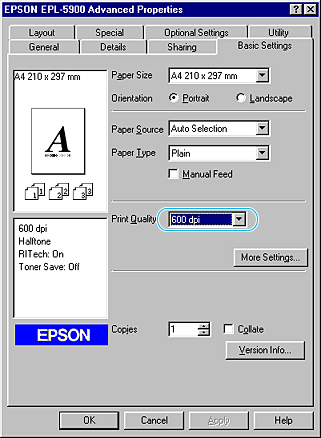
 |
Click OK to accept the setting.
|
 |  |
Note:
|
 |  | -
For details about the Enh. MG or RITech functions, see the Online Help.
|
 |  | -
If printing is unsuccessful or a memory-related error message appears, selecting a lower resolution may allow printing to proceed.
|

[Top]
Resizing printouts
You can have your document enlarged or reduced automatically during printing.
To automatically resize pages to fit the output paper
 |
Click the Layout tab.
|
 |
Select the Zoom Options check box.
|
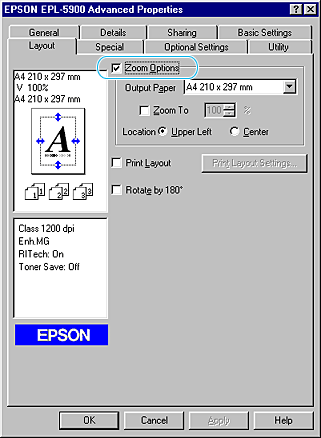
 |
Select the desired paper size from the Output Paper drop-down list. The page will be printed to fit on the paper you have selected.
|
 |
Select Upper Left for Location to print the enlarged or reduced page image at the upper left corner of the paper. Select Center to print the enlarged or reduced page image with centering.
|
 |
Click OK to accept the settings.
|
To resize pages by a specified percentage:
 |
Click the Layout tab.
|
 |
Select the Zoom Options check box.
|
 |
Select the Zoom To check box.
|
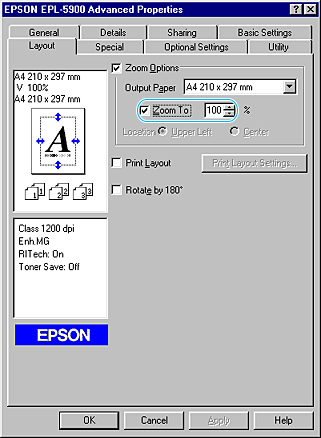
 |
Specify the magnification percentage in the box, then click OK. The percentage can be set between 50% and 200% in 1% increments.
|
If necessary, select the paper size to be printed from the Output Paper drop-down list.

[Top]
Modifying the print layout
"Layout printing" prints either 2 or 4 pages onto a single page and specifies the printing order, automatically resizing each page to fit the specified paper size. You can also choose to print documents surrounded by a frame.
 |
Click the Layout tab.
|
 |
Select the Print Layout check box, and click Print Layout Settings. The Print Layout Settings dialog box appears.
|
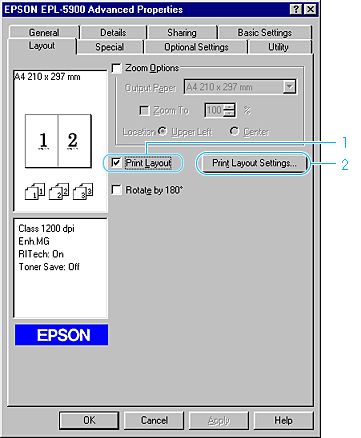
 |
Select the number of pages you want to print on one sheet of paper.
|
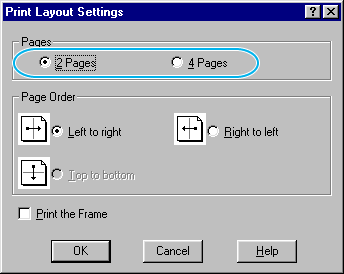
 |
Select the Page Order in which the pages are printed on each sheet.
|
 |  |
Note:
|
 |  |
The Page Order choices depend on the Pages selected above, and the paper orientation (Portrait or Landscape) selected on the Basic Settings menu.
|
 |
Click OK to close the Print Layout Settings dialog box.
|
 |
Click OK on the Layout menu to accept the settings.
|

[Top]
Using watermarks
Follow the steps to use a watermark on your document. In the Watermark dialog box, you can select from a list of predefined watermarks, or you can select a bitmap (.BMP) or text (.TXT) file as your own custom watermark. The Watermark dialog box also allows you to make a variety of detailed watermark settings. For example, you can select the size, intensity, and position of your watermark.
 |
Click the Special tab.
|
 |
Select the Watermark check box.
|
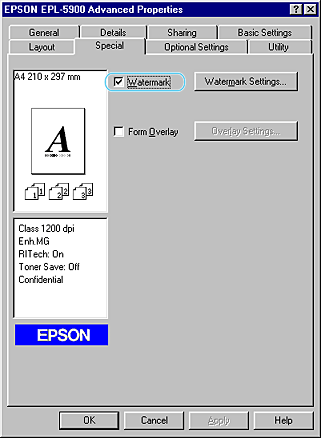
 |
Click Watermark Settings. The Watermark dialog box appears.
|
 |
Select a watermark from the Watermark Name drop-down list.
|
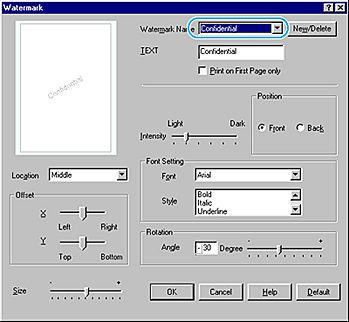
 |
Select the location on the page where you want to print the watermark from the Location list box.
|
 |
Adjust the horizontal or vertical Offset position.
|
 |
Adjust the image intensity of the watermark with the Intensity slider bar.
|
 |
Adjust the size of the watermark with the Size slider bar.
|
 |
Select Front (to print the watermark on the face of the document) or Back (to print the watermark on the backside of the document) for the Position setting.
|
 |
Click OK to accept the settings.
|
Making a new watermark
You can make a new watermark as follows:
 |
Click the Special tab.
|
 |
Select the Watermark check box.
|
 |
Click Watermark Settings. The Watermark dialog box appears.
|
 |
Click New/Delete. The User Defined Watermarks dialog box appears.
|
 |
Select Text or BMP and type a name for the new watermark in the Name box.
|
 |
If you select Text, type the watermark text in the Text box. If you select BMP, click Browse, and select the BMP file you want to use, then click OK.
|
 |  |
Note:
|
 |  |
Before making a custom watermark, you should prepare a bitmap (.bmp) file.
|
 |
Click Save to close the User Defined Watermarks dialog box. Your watermark will appear in the list box.
|
 |
Click OK to register the new watermark settings.
|

[Top]
Using an overlay
The Overlay settings dialog box allows you to print form data overlaid with data made by another application.
 |
Note:
|
 |
The overlay function is available only when the High Quality (Printer) is selected for the Graphic Mode in the Extended Settings dialog box from the Optional Settings menu.
|
Creating an overlay
You can create form data and save it as a file.
 |
Open the application that you will use to create the overlay.
|
 |
From the application, access the printer driver. Open the File menu and choose Print or Print Setup. Then click Printer, Setup, Options, or Properties, or click a combination of these buttons, depending on the application you use.
|
 |
Select the Special tab.
|
 |
Select the Form Overlay check box, and click Overlay Settings to open the Overlay Settings dialog box.
|
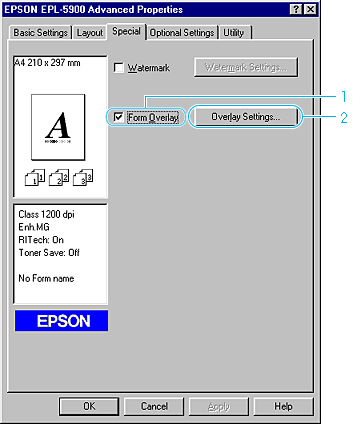
 |
Click Create Overlay Data.
|
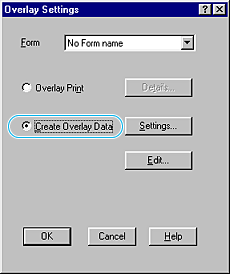
 |
Click Settings.
|
 |
Select the Use Form Name check box. Then click Add Form Name. The Add Form dialog box appears.
|
 |
In the Add Form dialog box, type the form name in the Form Name box and its description in the Description box.
|
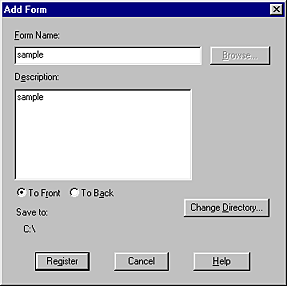
 |
Click To Front (to print the overlay on the face of the document) or To Back (to print the overlay on the back side of the document).
|
 |
In the Add Form dialog box, click Register.
|
 |
In the Form Settings dialog box, click OK.
|
 |
In the Overlay Settings dialog box, click OK. If you want to stop the procedure, click Cancel.
|
 |  |
Note:
|
 |  |
The file you send to the printer after step 10, from an application program such as Windows Notepad or Word, will be saved as an overlay using the form name you entered at step 8.
|
 |
Print the file saved as overlay data. It is possible to save any kind of file as an overlay. The overlay data is created.
|
Printing with an overlay
Follow the steps to print a document with overlay data.
 |
Open the file to print with overlay data.
|
 |
From the application, access the printer driver. Open the File menu and choose Print or Print Setup. Then click Printer, Setup, Options, or Properties, or click a combination of these buttons, depending on the application you use.
|
 |
Select the Special tab.
|
 |
Select the Form Overlay check box, and click Overlay Settings to open the Overlay Settings dialog box.
|
 |
In the Overlay Settings dialog box, choose the form from the Form list, then click OK.
|
 |
Click OK to print the data.
|
Different printer settings overlay data
The overlay data is made with the current printer settings such as Resolution: 600 dpi. If you want to make the same overlay with different printer settings such as 1200 dpi, follow the instructions below.
 |
Make the printer settings and exit the printer driver.
|
 |
Send the same data that you made by application to the printer as in step 12 in Creating an overlay.
|
This setting is available only for Form Name data.

[Top]
Resetting the toner and the photoconductor counters
After replacing a developer cartridge or a photoconductor unit, reset the toner counter or the photoconductor counter. You can reset these counters from the printer driver or a control panel.
Resetting the toner counter
 |
Click the Optional Settings tab, and then click Printer Setting. The Printer Setting dialog box appears.
|
 |
Click Toner Level Clear. The toner clear dialog box appears.
|
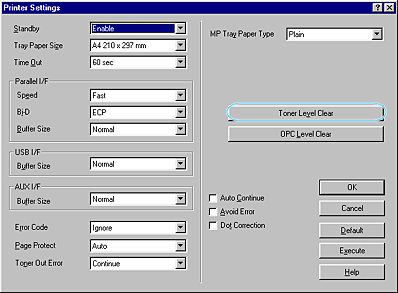
 |
Click OK to reset the toner level counter.
|
Resetting the photoconductor counter
 |
Click the Optional Settings tab, and then click Printer Setting. The Printer Setting dialog box appears.
|
 |
Click OPC Level Clear. The photoconductor clear dialog box appears.
|
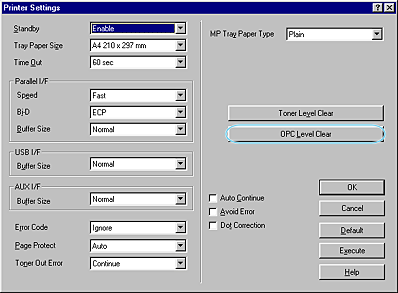
 |
Click OK to reset the OPC level counter.
|

[Top]
| Version 1.00E, Copyright © 2002, SEIKO EPSON CORPORATION |
Choosing the print quality
Resizing printouts
Modifying the print layout
Using watermarks
Using an overlay
Resetting the toner and the photoconductor counters